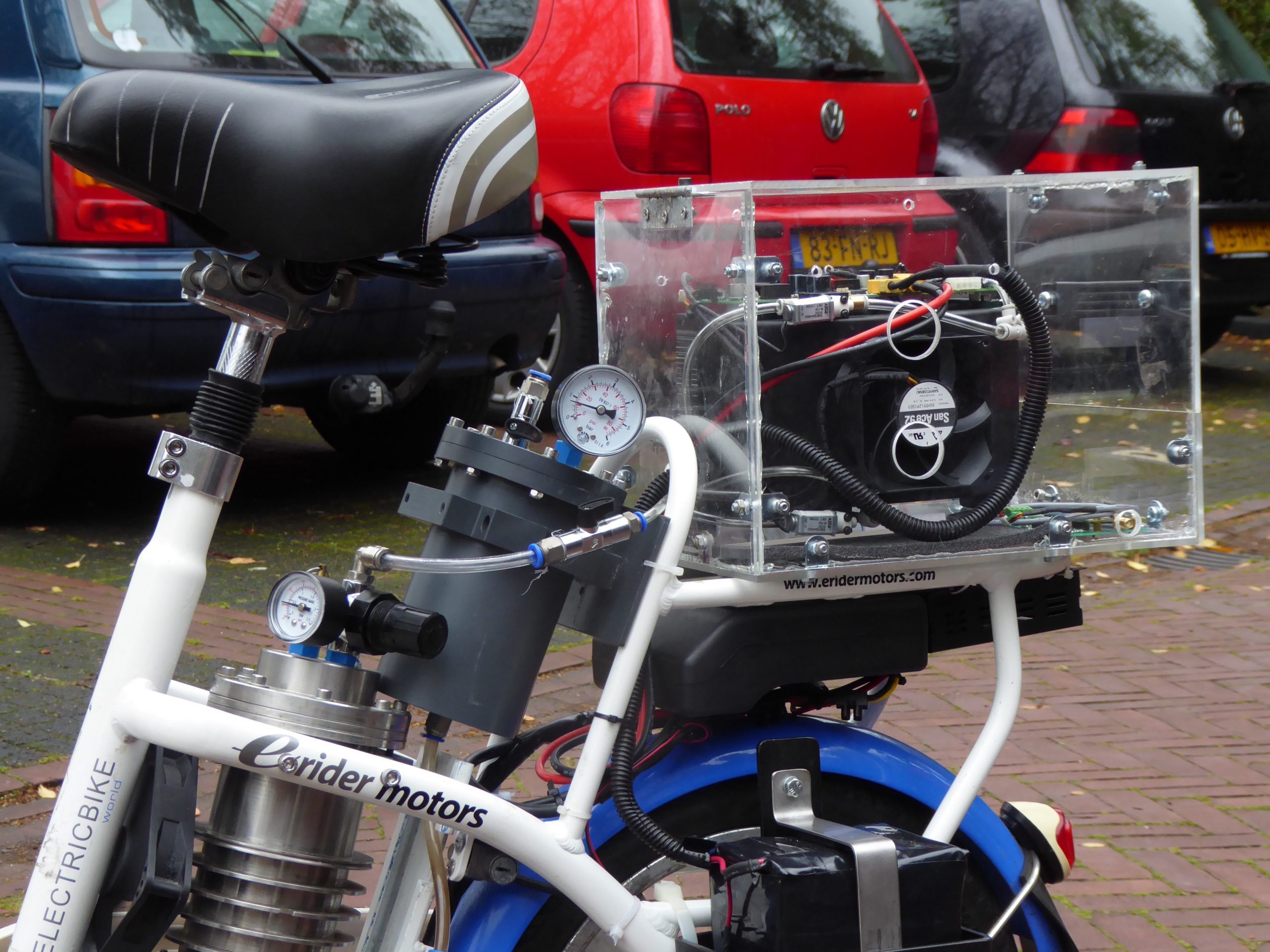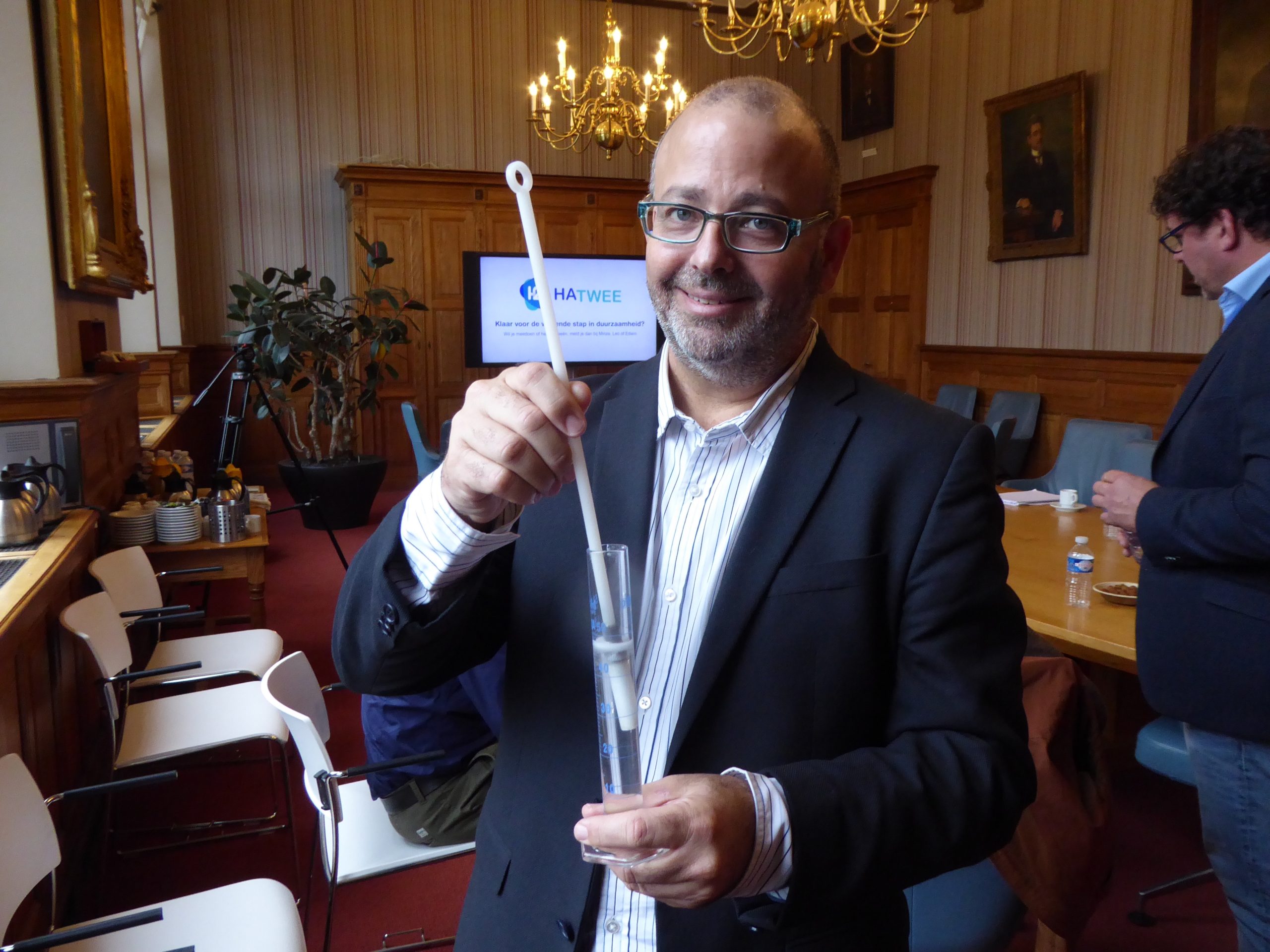The Israeli start-up, Terragenic, claims it can store hydrogen in a solution and retrieve it at ambient pressure and temperature. Applications for trucks and drones are under development.
Terragenic’s CEO, Guy Michrowski, told the audience about their hydrogen solution based on borohydride. Because of its large hydrogen content, borohydride (BH4-) was studied for hydrogen storage. But because of problems with slow hydrogen release and the regeneration of the spent solution, most researchers involved in hydrogen storage dropped borohydride in favour of ammonia or pressurised hydrogen.
Either Terragenic‘s ‘energy on demand’ is the best energy news in years, or it is an ingenious scam. See what you think.
 Hydrogen from solution and fuel cell power the e-bike. (Photo: Jos Wassink)
Hydrogen from solution and fuel cell power the e-bike. (Photo: Jos Wassink)Last week, just outside the campus, the Israeli start-up Terragenic demonstrated a hydrogen e-bike. The fuel cell, which converts hydrogen into electricity, was mounted on the rear. But there was no pressure tank for the hydrogen. Instead, the e-bike had a small plastic fuel tank and a metal vessel that generated hydrogen from the liquid. Visitors to the event, organised by mobility advisor Advier and licence-holder HaTwee, could try the hydrogen bike and experience its silent and exhaust free mobility.
Terragenic’s CEO, Guy Michrowski, told the audience about their hydrogen solution based on borohydride. Because of its large hydrogen content, borohydride (BH4-) was studied for hydrogen storage. But because of problems with slow hydrogen release and the regeneration of the spent solution, most researchers involved in hydrogen storage dropped borohydride in favour of ammonia or pressurised hydrogen.
Most researchers, but not Dr Alex Silberman, who had studied electrochemistry in the Ural and moved to Israel, where he started his applied research on borohydride in 2006. Three years later, he had cracked the kinetics (fast release of hydrogen) process, the stability of the solution and the recycling of the spent fuel. He patented the controlled generation, storage and transportation of hydrogen for mobility in 2009. He also patented the catalyst that released the hydrogen from the solution quickly enough. Recently he added another patent for the second-generation hydrogen solution with double the energy content.
According to Michrowski, the net energy content, from fuel to wheel, is 0.7 kWh per kilogram of fuel, and the second generation produces 1.6 kWh of energy per kilogram. These figures seem low in comparison with fossil fuel (typically 13 kWh/kg). But remember the overall efficiency of a motorcar is about 20%, reducing the net energy content to 2.6 kWh/kg for fossil fuel. So you will probably need more borohydride solution than fossil fuel, but not double as much.
Terragenic is already working with OEM truck equipment on a hydrogen-based van and is looking into the potential of drones, another field of development. Michrowski told the audience in the Science Centre that, in comparison with batteries, Terragenic’s hydrogen solution could keep a drone in the air more than twice as long.
Michrowski visited the Netherlands to look for investors and business cases for mobile power. As an example, he presented the development of an electrical 700-Watt tricycle for deliveries. Current models in India and China have lead-acid batteries and a range of 25 kilometres. Solved hydrogen could increase the range to 60 kilometres and refuelling time would be five minutes instead of five hours. Could that make them attractive for Dutch cities as well?
 Editor driving hydrogen-powered e-bike. (Photo: Minze Walvius, Advier)
Editor driving hydrogen-powered e-bike. (Photo: Minze Walvius, Advier)Silberman hasn’t published scientific articles, and he doesn’t work with academia. Could it be that one of the most exciting developments in energy storage is being developed outside of regular science? Or have I overlooked something? Let me know what you think.
Do you have a question or comment about this article?
j.w.wassink@tudelft.nl


Comments are closed.